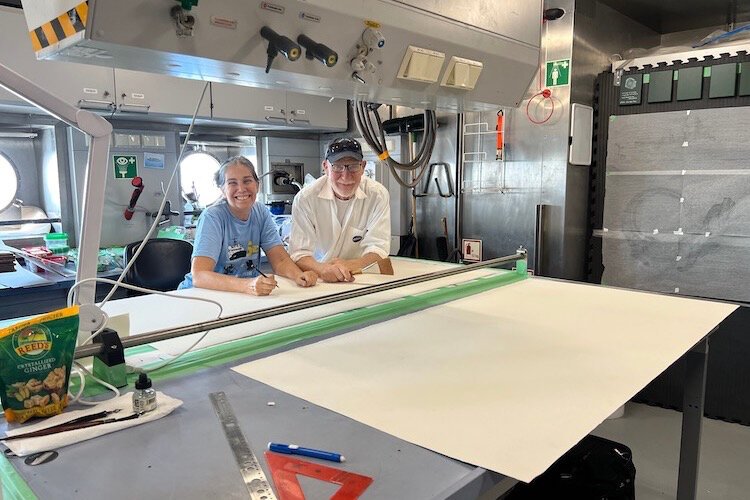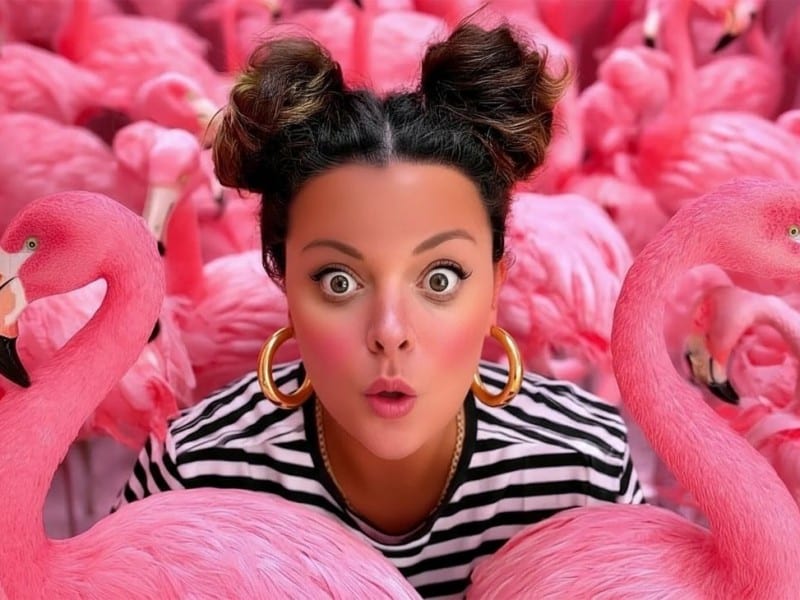Local artists head to sea to capture essence of research vessel
Florida artists Carol Mickett and Robert Stackhouse are crossing the ocean aboard the Falkor to capture its essence in paintings, images, and film while calling attention to climate change.
There is no science going on at the moment aboard the Schmidt Ocean Institute’s Falkor. However, there are boxes aboard the ship to pack up electronics and other equipment used to explore the ocean’s depths.
The research conducted on the Falkor is subsidized, then shared with the public and other research scientists. But for now, the ship is simply making its way across the ocean, no scientists aboard.
Enter Carol Mickett and Robert Stackhouse, renowned Florida artists who often use science in their art. The pair, who helped bust down the barriers that once prevented artists from living and working in the same space in St. Petersburg, are well known in art circles for their work on projects like Expanding Waters, a show they did with Creative Pinellas as its artist laureates to highlight the evils of climate change and sea-level rise.
These days, they are sailing off the coast of Central America on the Falkor, capturing its essence in paintings and sharing their work with the public through daily Instagram and Facebook posts.
Soon, they plan a ship-to-shore interaction through The Dali museum, to speak to those interested in learning more about their journey, which for now, is taking them to Panama.
“I was doing conversations at The Dali and invited Jyotika Virmani to be a guest,” Mickett recalled on a Zoom call from off the coast of Mexico. “We had an interview and we became friends. When we had an opportunity to do something with the VoLo Foundation, she mentioned that not only were there scientists on board the Falkor, but that there was an ‘artist at sea’ program and an artist would also be on board.”
The VoLo Foundation does data-driven research to promote positive change in the world.
Mickett and Stackhouse submitted a proposal to the Schmidt Ocean Institute “and here we are,” she says.
“We do art about water, about oceans and climate change and Robert is known in his work for doing lots of paintings about ships and so that is what we are working on.”
Each day, the couple films one of them dropping an ice cube into the ocean, symbolizing the need to cool the warming waters.
“We do it every day at 2 p.m. and record the latitude and longitude and the water temperature,” Mickett says. “A drop in the ocean. One drop in the ocean.”
It’s symbolic, she says, but gets the point across.
And each day the couple makes a small painting of the ice cube with the statistics and hangs it in their onboard studio.
“The ice cubes are made out of ocean water, so it is a symbol that we all have to act to cool the waters,” Stackhouse says.
The couple is also creating a very detailed 30×60 painting featuring the research vessel and Falkor, a luck dragon, draped across the ship in gold. “Falkor is the spirit that guides everyone,” Mickett explains.
Before it is finished, each crew member and scientist will sign the painting in gold. Then, it will hang aboard the Falkor Too, the new research vessel that will replace the original within a year once the crew picks it up in Spain.
“The new ship is twice the size of this one and can get through thin ice,” Stackhouse says.
“We’ve really been able to feel the spirit of this ship,” Mickett says. By having the crew sign the painting, she says, “it will provide ownership of the merging of the spirit and the body, or the ship and it’s spirit.”
Follow the artists on Instagram @mickett_stackhouse_studio or on Facebook to see photos and videos from their most recent work. Or find them online at Mickett-Stackhouse Studio.
















